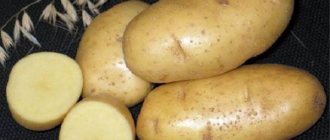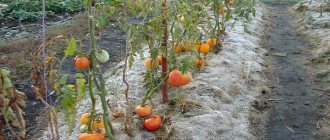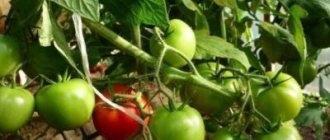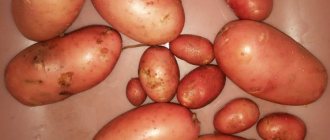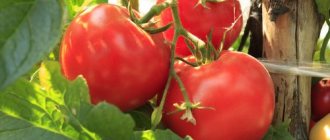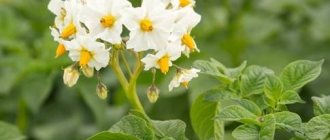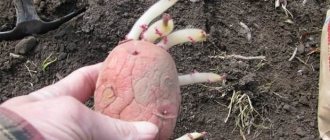Potato Bullfinch - what kind of variety, description
Gardeners and farmers sometimes find it difficult to choose which potatoes to plant, since many varieties of the vegetable have been developed over the past decades.
Due to its characteristics, good reviews from gardeners and the taste of the variety, the Snegir potato quickly gained popularity among Russian vegetable growers.
Ripening time and yield
Bullfinch is an early ripening potato. From planting in the ground to harvesting - 1.5–2 months.
Subject to agricultural practices and careful care, vegetable growers harvest up to 300 centners of potatoes per hectare.
Potato variety Bullfinch
- The plant is low (a little more than half a meter) with a strong, straight stem. The bush takes up little space, which is convenient for small summer cottages.
- The dense foliage is dense. The leaves are large, but not wavy like most potatoes.
- The roots of the plant are strong, fruits are formed on them (up to 16 pieces in one root nest).
- Flowering lasts no more than half a month. Small flowers are purple-red.
Additional Information! In regions with a warm climate (southern regions), gardeners have time to grow crops twice.
Bullfinch bushes
Disease resistance
The variety is resistant to many crop diseases. He is not afraid:
- potato cancer;
- common scab;
- fusarium;
- late blight (affects exclusively the tops, without affecting the tubers).
The variety has weak immunity to the golden nematode, which is attributed to one of the disadvantages of Bullfinch.
Important! When carrying out timely preventive treatments of potato bushes, the nematode pathogen is powerless.
Characteristics of tubers
The tubers of the Bullfinch variety are round-oval in shape. In appearance, the potatoes are even, smooth, with a few small eyes.
- Tubers are medium-sized, weighing up to 100 g.
- The peel is reddish, thin in appearance, but durable.
- The white flesh is tender and light.
Note! The variety is often confused with Picasso potatoes. In order not to make a mistake when purchasing planting material, you must remember that the Bullfinch seed potato differs from other varieties in the absence of dark spots near the eyes.
For which regions is it suitable, climate requirements?
The variety was bred for the purpose of cultivation in short and cool summer conditions. It was recommended by breeders for cultivation in the Northern, Northwestern, Far Eastern and Central regions.
This variety is happily grown by potato growers both in the north and south of the country, harvesting 2 crops a year. In the west and east, in the Urals and Siberia.
The variety is unpretentious, frost-resistant. We especially love it among Siberian vegetable growers.
Taste qualities
On a ten-point scale of tasters, the variety received a rating of 7. According to the reviews of most gardeners who grow this variety, the potatoes are tasty.
- The pulp is crumbly, not watery.
- Long-term storage spoils the taste of potatoes.
- In Bullfinch tubers, the amount of starch (16%) exceeds the established norm by 0.8%.
The variety is called universal. Bullfinch potatoes are delicious in both soups and salads; boiled, fried, baked.
Origin story
The bullfinch was bred at the Northwestern Scientific Research Institute of Agriculture and the Vavilov Institute of General Genetics.
It is in demand among small farms and gardeners who grow potatoes on their plots.
High yields were noted when grown in the North-West region.
Planting and growing potatoes of the Snegir variety
To ensure that the future harvest does not disappoint, you must follow certain rules of agricultural technology. The planting of the Bullfinch is traditional.
Preparing for landing
From mid-spring (April) they begin to prepare planting material. If the seeds are prepared independently, then all that remains is to germinate and process them.
Important! It is advisable to buy Snegir seed potatoes from trusted sellers in order to avoid being deceived with the variety and not purchasing infected tubers.
Before planting, they are treated against diseases for the purpose of prevention, for example:
- copper sulfate;
- Aktaroy;
- Maxim;
- Fitosporin.
Important! When using chemicals, you must strictly follow the instructions for use indicated by the manufacturer on the packaging.
Some gardeners do not spray the tubers before planting, but sprinkle them with ash.
In 3–4 weeks, seed potatoes are germinated and taken outside. The air temperature should not be lower than +11°C. Sprouting sprouts on tubers will speed up the emergence of seedlings.
Soil requirements
Light and fertile soils are the most suitable for growing Bullfinch potatoes, as well as any other variety. On heavy loams, you can’t expect a rich potato harvest.
- The soil for planting vegetables is prepared in the fall: it is dug up and fertilized with organic matter (manure, humus, peat).
- It is enough to loosen loose, light soil in the spring. If the soil is heavy, then they dig it up, but not as deep as in the fall (half a shovel's length).
- Potatoes are not grown in places where peppers or tomatoes were grown, since the plants have common diseases. Planted after cucumbers, legumes, and corn.
- Add mineral fertilizers or ash to the soil. Some gardeners pour directly into the planting hole.
Many summer residents use the drug “Bulba”, which is based on ash (100 g of product per 10 kg of seed potatoes).
Note! It is permissible to plant potatoes in the same place no earlier than the fourth year after the first planting.
Dates, scheme and rules of planting
The planting time of the Bullfinch largely depends on the climatic conditions of the region.
In the northern regions, potatoes are planted from mid-May to mid-June, and in the southern regions - in late April-early May. At the end of the first summer month, a secondary planting is carried out.
- The main thing is to wait until the earth warms up to +12°C and the night frosts pass.
- Snegir potatoes are planted according to the following scheme: row spacing is at least 45–50 cm, and the intervals between planting holes are 30 cm.
- Each tuber with a sprout (3–4 cm) is buried 10–12 cm in a separate hole.
- They dig in and level the soil using a rake.
Planting scheme
After 2–3 weeks, the potatoes will sprout.
Landing Features
Seed preparation is carried out from late April to early May. Tubers for planting must be of high quality; they must be purchased either through official representatives or in other trusted places. Unscrupulous sellers sometimes sell low-quality contaminated fruits or offer a completely different variety under the guise of Bullfinch.
In addition to selected planting material, the composition of the soil affects the quantity and quality of the future harvest. The bullfinch grows well and bears a lot of fruit in fertile, breathable soil. Before planting, the soil is fertilized with organic fertilizers: ash, mullein, dug up and leveled. Then, from the beginning of May, the planting process begins:
- tubers are treated with the preparations “Zircon”, “Immunocytophyte”, “Fitosporin”. Since Bullfinch sometimes contract diseases, pre-treatment reduces this likelihood;
- dig small holes in the ground with a diameter of 30 cm. The distance between adjacent holes should be at least 20 cm, and between adjacent rows - at least 40 cm. The variety does not tolerate dense planting and if there is not enough space, tuberization proceeds worse;
- When planting, potassium fertilizers are added to the holes; they support the plant’s immunity and protect against nematodes. Sometimes, for the same purpose, ash is added to the ground, about a handful for each planted tuber;
- The hole is buried and watered with cool water.
Attention! The maximum depth for planting fruits should not exceed 10 cm. If you bury the potatoes when planting, the tops will take a very long time to sprout.
How to harvest and store crops
The Snegir potato ripens 1.5 months after germination, at which time it can already be dug up. The potatoes are completely ready in 2 months.
Storage features and keeping quality of the Bullfinch variety
The time for digging up potatoes depends on the climate in the region.
- Vegetables are dug up in clear and dry weather.
- Before storing potatoes, you need to dry the tubers. For this purpose, it is placed under a canopy, in a well-ventilated place, or in a room with ventilation.
- They sort through, selecting only healthy and clean potatoes, and put them in wooden boxes or nets.
- After drying and sorting, the potatoes are put away where it is cool and dark (underground, cellar).
Important! It is unacceptable to dry tubers in direct sunlight.
Harvest and storage
Since the Bullfinch variety is early, it is not stored for a long time. At the same time, gardeners note its good keeping quality (up to 95%).
Snegir potatoes last for a long time even at temperatures no higher than 4 °C. This is important for storage in northern regions. However, many note that the longer the tubers are stored, the worse their taste.
Protection from diseases and pests
The Bullfinch variety is resistant to fungal and viral diseases. Due to the early ripening of the tubers, late blight is not affected, but in rainy seasons, even such early ripening varieties require prevention.
Plantings are sprayed against fungal infections with copper-containing preparations (copper sulfate, Bordeaux mixture), biological agents Gamair, Planriz. The first treatment is carried out in the single budding phase, and again after 3 weeks. It is useful to dust the rows with ash.
For pests (nematodes), biological products Nemabact and Bitoxibacillin are used. It is effective to plant marigolds and calendula next to potato beds, whose aroma repels dangerous insects.
Advantages and disadvantages
The advantages of the Bullfinch variety are:
- Great taste.
- Culinary versatility - the variety is suitable for preparing any dishes.
- Resistance to many diseases.
- Fast maturation. Bullfinch can be eaten already on the 45th day after planting, before full maturity.
However, there are also disadvantages:
- Nematode vulnerability.
- Relatively low yield.
Planting a crop on the site
For planting crops, deadlines are observed depending on the region of cultivation, the density of tubers in the bed, and the manipulation algorithm.
Landing times in different regions
The Bullfinch variety is suitable for cultivation in all regions. It produces high yields in Siberia and the Urals. The tubers are transferred to the soil when it warms up to 10°C, to a depth of 10 cm.
Related article: Potato variety “Sylvana” - description and photo
Potatoes are planted there at the end of May, and the harvest is harvested at the end of June or beginning of August.
In regions with a temperate climate, planting is carried out in mid-May or early June. In the southern regions, planting begins in May, the first harvest is harvested, and the second one is carried out at the end of June.
Step-by-step algorithm for carrying out planting work
Potatoes are planted according to the following algorithm:
- In the prepared area, beds are formed and holes are dug.
- The seed material is treated with a manganese solution.
- A small amount of water is poured into the hole.
- Place drainage material.
- Each tuber is placed in its own hole to a depth of 10 cm.
- Buried with earth.
- The bed is leveled with a rake.
Taste and product characteristics
The main advantages of this variety:
- Friendly maturation;
- It has excellent keeping quality - 95%;
- Excellent taste.
REFERENCE: The only drawback is the susceptibility of the variety to some diseases, for example, nematodes.
In terms of taste, the pulp of the “Bullfinch” variety does not contain excessive dryness or wateriness. The only caveat is that potatoes have a slightly increased level of starch. The indicator is 0.7% higher than the established state standard. Tubers contain a lot of vitamin C and A. Other advantages and disadvantages of the variety.
| Advantages | Flaws |
| Unpretentious to breeding conditions | Tops are susceptible to late blight. It is necessary to carry out preventive measures regularly |
| Minimum set of soil requirements | — |
| The gardener is required to use a minimum agrotechnical set | — |
| Resistant to cancer, viral pathogens, nematode | — |
| Handles transportation well | — |
| Precocious | — |
Seed material is purchased at the store and then processed. This reduces the likelihood of pathogens being introduced into the garden bed.
Reviews about the variety
The “Bullfinch” potato is characterized by many gardeners as a wonderful early variety that has proven itself well in almost any type of soil and in any region. The variety belongs to the category of new products, but is already assessed as the most promising for homestead farms. Potatoes of this variety are unpretentious, adapt well to unstable weather conditions and do not cause any problems during cultivation.
Reviews from potato growers are mostly positive. The variety is drought-resistant, produces smooth tubers, they are free of new growths and secondary tubers. “Bullfinch” is a beautiful variety, and many consumers have recently really liked potatoes with red or pink tubers. In addition, the variety is attractive because when cooked it becomes crumbly and quite aromatic, and its tubers are ideal for roasting over coals or in the oven.
How to grow
Inventory
If the Bullfinch variety is grown on a personal plot or summer cottage, then it is enough to have a shovel, a hoe, a rake and a couple of buckets. When growing in relatively large areas, you can use :
- Attachments for a walk-behind tractor or mini-tractor (seeder, cultivator, hiller, etc.).
- Potato planters and harvesting units. However, this is practiced less frequently, since the Snegir variety is not intended for industrial breeding.
Preparation
The soil
For early potatoes, the plot is prepared in the fall:
- It is plowed up (with the formation wrapped around) or dug up to the fullest extent without breaking the lumps (they are needed for snow retention in winter).
- When digging, organic fertilizers are applied:
- peat;
- compost;
- humus or fresh manure.
- Organic matter is evenly scattered around the site so that it mixes with the soil when plowing or digging.
In the spring the area is loosened again:
- It is dug up half a bayonet or disked using special plowing equipment.
- Then it is harrowed or leveled with a rake. At this stage, you can again add organic matter, but only rotted one - fresh manure is unacceptable. It is also useful to add wood ash or bone meal (a glass at the root of each bush when planting).
Planting material
Seeds are selected in the fall during harvesting . For sowing, medium-sized tubers are selected, no smaller than a chicken egg. Only potatoes that do not show signs of disease or mechanical damage are selected. About a month and a half before planting, the potatoes should be sprouted.
To do this, it is placed in a warm (at least +14-15 degrees) and well-lit room. At this stage, seed tubers are additionally inspected and those damaged or diseased during storage are rejected. When the potatoes produce their first sprouts, they are ready for planting. Those tubers that have not begun to grow are rejected and disposed of.
Attention!
Additionally, before planting, tubers can be treated with preparations such as “Prestige”, “Heteroauxin” or similar. This will accelerate growth and protect the plants during the first stage of the growing season.
Landing times in different regions
It is worth planting Bullfinch when the soil warms up to +6-8 degrees at a depth of 10 cm. This time comes in each region (and even each locality) individually, but you should focus on the following data:
| Agricultural region | Boarding time |
| Volgo-Vyatsky | Beginning of May |
| Far Eastern | Second half of May |
| Northern | End of May – beginning of June |
| Northern | End of May – beginning of June |
| Northwestern | Mid to late May |
| North Caucasus (together with Crimea) | Early April |
| Siberia | End of May – beginning of June |
| Middle Volga | Beginning of May |
| Ural | End of May – beginning of June |
| Central Black Earth | First ten days of May |
| Central | Beginning of May |
Scheme
Potatoes Snegir are planted according to the standard scheme:
- Between rows - about 70 cm.
- Between bushes in a row - 30-35 cm.
Important!
Tubers are planted to a depth of 6-7 cm. Do not go deeper - this will slow down growth.
Care
Hilling
The first hilling is carried out when the tops are about 10-12 cm high . Hilling can be done manually or by plowing the rows or using a hiller on a walk-behind tractor.
If there is a threat of frost, hilling can be done even earlier, but this measure may slow down the growth of the stems. Subsequent hillings (1-2) are carried out during the summer after 15-20 days.
Watering
If there is no drought, the Bullfinch variety does not need additional irrigation. If there has been no rain for a long time, then several waterings are carried out:
- One and a half to two weeks after the potatoes have sprouted.
- When buds set.
- During flowering.
Watering potatoes at sunset . If drip irrigation is used, the time of watering does not matter.
Loosening
The first loosening is carried out 3-4 days after the potatoes are planted. The soil is loosened shallowly so as not to touch the tubers or sprouts. Loosening should be done with a rake with sharp tips to break up the crust on the soil and destroy the germs of weeds.
Advice
During growth, it is worth loosening regularly, once every 10-12 days. In addition, it is better to combine loosening with weeding.
Weeding
Weeding is carried out as weeds appear . There are no exact dates, but usually they weed at least 3-4 times per season.
Top dressing
With sufficient autumn and spring feeding, the Bullfinch variety does not need additional fertilizer. If it was not possible to apply fertilizer in advance, or the plants are not developing well, you can feed the potatoes with an infusion of mullein or bird droppings.
also use mineral fertilizers, except nitrogen ones - they excessively enhance the growth of tops. The best choice is nitrophoska and complex fertilizers in the dosage specified by the manufacturer. If there is less than a month left before ripening, fertilizing should not be carried out under any circumstances.
Other measures
In addition to the above measures, potatoes can be mulched with mowed grass.
